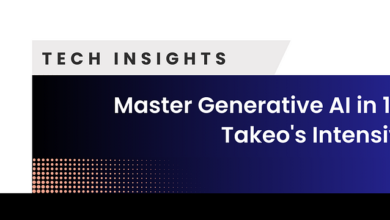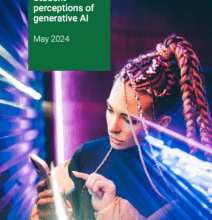Experts See Generative AI’s Potential to Transform Public Health

Even as concerns continue over the sub-optimal use of artificial intelligence (AI), particularly that of generative AI, in healthcare, some healthcare leaders and researchers see tremendous opportunities for transforming the United States’ public health infrastructure using generative AI tools.
In that regard, a team of experts—Monica Bharel, M.D., M.P.H., John Auerbach, Von Guyen, and Karen B. DeSalvo—has authored a commentary article published in the June issue of Health Affairs, entitled, “Transforming Public Health Practice With Generative Artificial Intelligence,” that gets to the heart of those experts’ optimism around generative AI. The theme of the June issue of the journal is “Reimagining Public Health.”
Monica Bharel, M.D., M.P.H., is clinical lead for public sector health at Google; John Auerbach is senior vice president for public health at the ICF consulting firm; Von Guyen, M.D., is clinical lead for population health at Google; and Karen B. DeSalvo, M.D., is chief health officer at Google (and was National Coordinator for Health IT from January 2014 through August 2016).
In the commentary, the authors write that “Public health is what a nation does together as a society to create and ensure the conditions in which everyone can be healthy. Periodically, circumstances call for a dramatic shift in the ways in which optimal health is promoted. Several years ago, coinciding with a renewed focus on the social and environmental determinants of health, a shift occurred to expand traditional public health agency programs to institutionalize greater cross-sector collaboration and communitywide approaches to reach whole populations and address health inequities. Emerging around this time, the Public Health 3.0 framework was intended to expand the scope of practice for public health. One important dimension of this framework calls on the public and private sectors to work together to make real-time, geographically granular data more widely available.3 Although the field has been evolving toward a 3.0 model, using data-driven approaches to improve health outcomes, the COVID-19 pandemic revealed the need to upgrade data systems and other technological capabilities, compelling public health to evolve even further,” they write.
What’s more, they state, “More specifically, to fully realize Public Health 3.0, public health departments need to explore ways to integrate technology and new generative artificial intelligence (AI) capabilities that have garnered public attention during the past two years. We believe that generative AI will provide transformative opportunities for public health officials to approach their work. In this Commentary, we explore current uses for AI and examine the advanced capabilities of generative AI, demonstrating how they can serve as a catalyst for advancing public health. We discuss ways in which generative AI can support public health practice, including core workflows, recognizing that new technologies are most effective when they can help staff members even in the smallest local health departments. Finally, we review the challenges and risks associated with these new technologies.”
The article’s authors go through and summarize some uses of AI technology that are already very actively being pursued, including the development of large language models for predictive purposes. When it comes to generative AI, they see three primary areas of promise: “public communication,” “organizational performance,” and “novel insights.”
With regard to public communication, the article’s authors note that “Generative AI has the potential to offer a more personalized experience” to members of the public. “Some experts have argued for the importance of precision public health, and generative AI will provide tools to meet the specific information needs of individuals and the public at large. Generative AI tools can more easily create materials at multiple literacy levels and in a range of languages spoken by communities. Materials can also be personalized to suit different geographic locations and cultural factors. Content can be shared across multiple media formats, including text, audio, and images. Image generators such as Image FX and DALL-E use language prompts to generate images.25,26 These could be used by public health officials to rapidly produce visuals to aid communication efforts,” they write.
Indeed, they state, “For instance, COVID-19-era images depicting social distancing, washing hands, and wearing a face mask are ingrained in the minds of billions of people around the world, crossing all international boundaries. These images were, arguably, more universally effective at communicating important health information than text or speeches in specific languages. With text-to-image AI image generators, the barrier to creating and testing visual resources has fallen dramatically for the average health department.”
When it comes to organizational performance, the article’s authors note that “Public health uses a bureaucratic system of checks and balances and public accountability based on specific regulations and laws. This system offers transparency to the public, but it can lead to extensive clerical burden for staff at all levels. Generative AI has the potential to reduce this clerical burden by summarizing and automating administrative tasks, organizing large amounts of data, and providing analytic support to free up valuable time for staff to engage in work at the top of their professional capacity.” Generative AI tools based on large language models, they argue, “can empower the analyst by searching, extracting, and summarizing information found within large amounts of written text. Removing this clerical burden will allow the analyst to spend more time reviewing the computer-generated summary; analyzing previous health policy proposals; and designing a more thoughtful, strategic recommendation to leadership,” among other improvements.
As for the third category, “novel insights,” the authors state that “Generative AI can facilitate advanced analytics to inform new interventions to address complex health issues. For example, unstructured notes on medical examiners’ case reports, social media activity, and news reports are all potential useful text signals that are currently inaccessible at a population level. New multimodal models are emerging that will be able to integrate additional data modalities such as imaging, genomics, environmental, and geographic data into models.”
Ultimately, they conclude, “Taken together, these applications have the potential to revolutionize health by making it easier to communicate with the public, increase organizational performance, and generate novel insights into complex health problems.”



